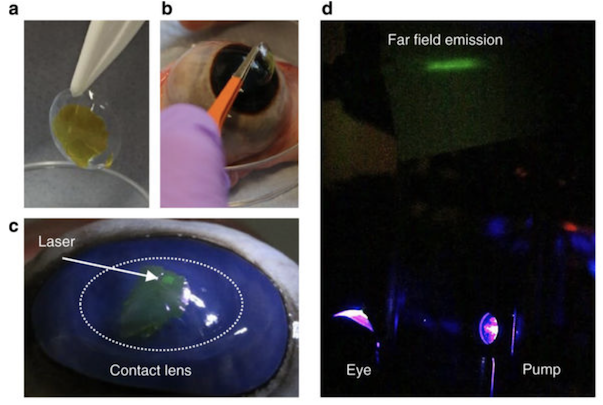Home
A comprehensive resource for safe and responsible laser use
Scotland: Scientists develop way to shoot laser light from eyes
The team from the University of St. Andrews demonstrated the new technology by putting a membrane laser onto a standard contact lens (photo a below), then placing this on a cow’s eye (photos b and c). A cow’s eye is similar to human eyes and is widely available as a byproduct of meat processing. The researchers then illuminated the eye with safe pulsed blue light (“Pump” in photo d) and “observed a well-defined green laser beam emerging from the eye” (“Far field emission” in photo d).

The diagram below shows the narrow wavelength of the emitted light (emission power on the left-hand scale is in “arbitrary units”).

The pump light minimum fluence to cause lasing was 58,800 W/cm², which is about one order of magnitude less than the maximum power density permitted by the ANSI 2000 standard for intentional and repeated ocular exposure. The researchers state that “a membrane laser on a contact lens could thus—under appropriate pumping conditions—be safely operated while being worn in the eye.”
Applications of the membrane laser include use as a security device affixed to banknotes or the human body (researchers also put a laser on a fingernail). A pumping beam is shone onto the substrate (banknote, eye, fingernail) to see if laser light of the expected wavelength is emitted. In the future, “[f]urther optimization of the DFB grating will likely allow lower lasing thresholds and facilitate LED pumping of membrane lasers. By combining recently developed roll-to-roll nanoimprint and organic ink jet printing technology, membrane lasers could be mass-produced with high reproducibility and at low cost.”
The researchers’ paper received widespread publicity, often with photos such as the one below. However, one of the authors, Prof. Malte Gather told the Express, “When we thought about this idea of making the laser membrane, someone suggested it was the first step towards making Superman real. It was meant as a joke but I thought it could be serious after all in certain applications. What is important for a normal human – not being Superman – is that our lasers are extremely efficient and hence can emit laser light that is not very bright. That excludes it from being used as a weapon but means that you could put it on to your eye without blinding yourself.”

From Nature Communications, volume 9, Article number: 1525 (2018), doi:10.1038/s41467-018-03874-w, available online here. Press release from University of St. Andrews. Typical popular press stories from U.S. News, USA Today, and the Express. A more detailed, science-oriented summary and discussion is from Optics and Photonics.
Scotland: Concern over using laser pens to banish pigeons from Parliament building
Hawks were originally used to scare pigeons away from the modern building, opened in 2004. When these proved unsuccessful, contractors turned to the laser pens. They are primarily used at dawn and dusk to disturb and disperse roosting pigeons.
A spokesperson for the Pigeon Control Advisory Service said “Laser pens can be lethal and blind animals and birds. They are definitely not something we would ever recommend.” PETA, People for the Ethical Treatment of Animals, also said the animals eyes could be damaged and that other humane, non-harmful methods should be used.
From the Edinburgh News, Jan. 23 2014. Thanks to Paul Bluesky for bringing this to our attention.
UPDATED Jan. 27 2014: The contractors said they must abandon the “no kill” policy in order to further reduce the pigeon population on the Scottish Parliament building. A Parliament spokesperson said there had been no change of policy. From the Edinburgh News
Scotland: Pilots want stepped-up prosecution against laser attacks
An April 2013 investigation by the Scottish Express found 338 incidents in Scotland from January 1 2011 through February 13 2013. Only 12, or 3.5 percent, had been solved. The paper noted that the International Air Transport Authority (IATA) suggests there are 12 incidents involving lasers each day globally. [Note: The U.S. rate is approximately 9-10 per day, indicating the rest of the world’s rate is 2-3 per day which LaserPointerSafety.com believes to be higher.] An IATA spokesperson said the organization “support[s] strong penalties for anyone caught engaging in the act.”
The U.K.’s Civil Aviation Authority said there were 152 laser incidents at Heathrow Airport in 2012, compared with 136 incidents at Glascow Airport which has 1/10 the number of passengers.
The Scottish Express story contains additional statistics on Scotland airport lasing rates.
From the Scottish Express
Scotland: 107 laser incidents in Glasgow in 2011
From the Scotsman